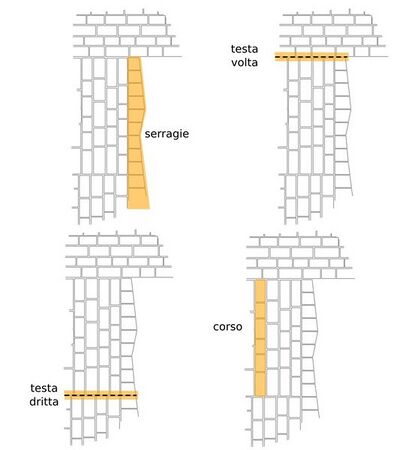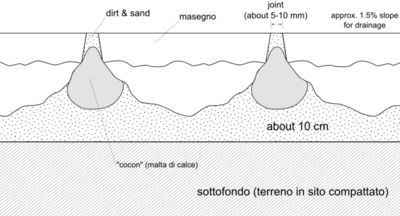Stone Pavement

The stone pavements in Venice have great historic value because they've been around for centuries. The supply of Trachyte is limited and therefore every stone is protected under Italian law. The main components of a Venetian stone pavement layout can be seen in the diagram on the right. Corsi, known in English as runs, are long vertical columns of stones having the same width but varying lengths. The corso layout makes up the majority of Venetion street pavement. The border of a street, which runs adjacent to buildings, is refereed to as serraggie. Serraggie are stones that have been turned 90 degrees, to better fit between the runs and uneven building fronts. When two perpendicular streets meet,the runs have to be reset, this is referred to as testa volta. Occasionally corsi running in the same direction must be reset in order to retain alignment of the stones, this is referred to as Testa Dritta.
Paving layouts
There are several different layout techniques that are seen throughout Venice. They all share some similarities; the main pattern runs along the center of the street while the edges consist of serragie, or stones turned 90° with respect to the rest of the street. This is so that the stones can more easily fill the gap between the straight edge of the regular paving pattern and the (often irregular) face of a building.
A correre
A correre translates to on the run. This layout consists of multiple vertical columns each refereed to as a corso, or run. The widths of each run are the same however the length varies. This creates an offset pattern that adds character to the Street. This layout can be made using any kind of Paving Stones.
Spina di pesce
Paving resembles the spine of a fish. For all stones used in the herringbone layout the length is twice the width. This technique is always done with Salizzoni.
Opera incerta
This layout is made up of recycled masegni or other irregular shaped stones. For this irregular layout, Mortar is used to fill the gaps between the stones. Because stones are layed out randomly the posa process is much simpler in this layout. Examples of opera incerta can be seen at St. Mark's Square.
Laying
The laying of stones is referred to as posa. This technique includes laying Stones down individually by hand after applying Mortar to the base of adjacent stones. A tool is then used to tap the stones down until flush with the rest of the Street.
Jointing Techniques

There are three common types of jointing techniques used in a Venetian street.
Giunto Unito
This jointing technique, known as "closed joints", is used in layouts using new masegni because the dimensions are more uniform and exact. The joints in this technique are about 5-10 mm wide and are filled in with dirt thus creating a more historic appearance which better suites Venice's aged appearance.
Giunto Fugato
Giunto fugato refers to a mortar joint. In this technique the masegni are not squared off and Mortar is used instead of dirt to seal the joints together. This layout was introduced in the 1930s as a means to save money and use fewer stones. The gaps in between stones must be in between 1-5 cm.
Giunto Fugato con Stilatura a Ferro
Stilatura a ferro translates to Ironed line joint. This technique is identical to the giunto fugato, except as the mortar is hardening, an iron tool is used to trace lines between the stones. This gives the stones a more regular appearance.
See Also
References
NULL